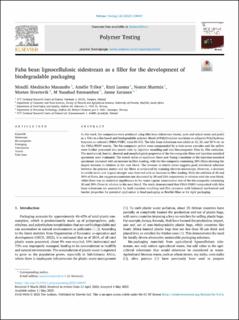| dc.contributor.author | Masanabo, Mondli Abednicko | |
| dc.contributor.author | Tribot, Amélie | |
| dc.contributor.author | Luoma, Enni | |
| dc.contributor.author | Sharmin, Nusrat | |
| dc.contributor.author | Sivertsvik, Morten | |
| dc.contributor.author | Emmambux, M Naushad | |
| dc.contributor.author | Keränen, Janne | |
| dc.date.accessioned | 2023-06-07T07:17:24Z | |
| dc.date.available | 2023-06-07T07:17:24Z | |
| dc.date.created | 2023-06-03T17:58:42Z | |
| dc.date.issued | 2023 | |
| dc.identifier.citation | Polymer testing. 2023, 123 1-10. | |
| dc.identifier.issn | 0142-9418 | |
| dc.identifier.uri | https://hdl.handle.net/11250/3070272 | |
| dc.description.abstract | In this work, bio-composites were produced using faba bean sidestream (stems, pods and mixed stems and pods) as a filler to a bio-based and biodegradable polymer blend of Poly(butylene succinate-co-adipate)/Poly(hydroxy butyrate-co-valerate) (PBSA/PHBV, ratio 85/15). The faba bean sidestream was added at 10, 20, and 30 % wt. to the PBSA/PHBV matrix. The bio-composite pellets were compounded by a twin-screw extruder and the pellets were further processed into tensile rods by injection moulding and into bio-composite films by film extrusion. The mechanical, barrier, thermal and morphological properties of the bio-composite films and injection moulded specimens were evaluated. The tensile stress at maximum force and Young's modulus of the injection moulded specimens increased with an increase in fibre loading, with the bio-composite containing 30% fibres showing the largest increase in relation to the neat blend. The increase in tensile stress suggests good interfacial adhesion between the polymer matrix and the fibres as evidenced by scanning electron microscope. However, a decrease in tensile strain and impact strength was observed with an increase in fibre loading. With the addition of 20 and 30% of fibres, the oxygen transmission rate decreased by 29 and 52% respectively in relation with the neat blend, while there was no statistical significance in the water vapour transmission rate of the bio-composite containing 20 and 30% fibres in relation to the neat blend. The study demonstrated that PBSA/PHBV composited with faba bean sidestream are processible by both injection moulding and film extrusion with balanced mechanical and barrier properties for potential application in food packaging as flexible films or for rigid packaging. | |
| dc.language.iso | eng | |
| dc.title | Faba bean lignocellulosic sidestream as a filler for the development of biodegradable packaging | |
| dc.title.alternative | Faba bean lignocellulosic sidestream as a filler for the development of biodegradable packaging | |
| dc.type | Peer reviewed | |
| dc.type | Journal article | |
| dc.description.version | publishedVersion | |
| dc.source.pagenumber | 1-10 | |
| dc.source.volume | 123 | |
| dc.source.journal | Polymer testing | |
| dc.identifier.doi | 10.1016/j.polymertesting.2023.108047 | |
| dc.identifier.cristin | 2151536 | |
| cristin.ispublished | true | |
| cristin.fulltext | original | |
| cristin.qualitycode | 1 | |
